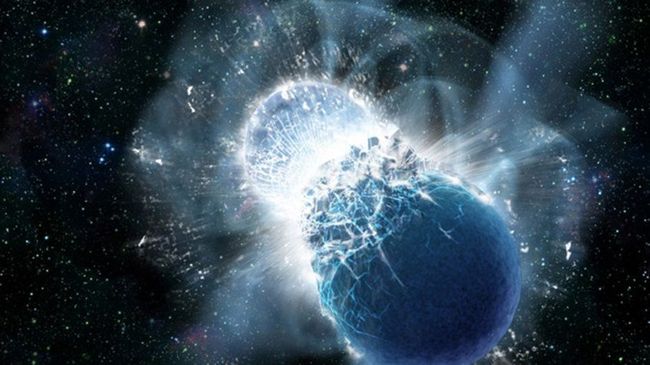Scientists have developed five novel isotopes in order to gain insights into the process by which gold is formed through the collision of neutron stars.
It is likely that these isotopes are appearing on the Earth’s surface for the first time.
Researchers at Michigan State University’s Facility for Rare Isotope Beams (FRIB) have successfully synthesized five new isotopes, namely Thulium-182, Thulium-183, Ytterbium-186, Ytterbium-187, and Lutetium-190. This groundbreaking achievement brings scientists one step closer to comprehending the formation of heavy elements like gold and silver through collisions between ultra-dense, deceased stars. These isotopes, which have never been synthesized on Earth before, mimic the conditions found in the turbulent environment surrounding merging neutron stars. Alexandra Gade, FRIB’s scientific director and a professor in MSU’s Department of Physics and Astronomy, expressed excitement about the progress made and the potential to delve even deeper into the astrophysical significance of these nuclei.
What’s an isotope?
Each element in the periodic table is uniquely identified by the number of protons present in its atomic nucleus. For instance, hydrogen consistently contains one proton, helium contains two, and iron contains 26. It is crucial to note that hydrogen cannot have two protons, and iron cannot have 25 protons; any deviation from these numbers would alter the identity of the elements.
Nevertheless, protons are accompanied by neutrons in atomic nuclei, and the quantity of neutrons can fluctuate without affecting the fundamental characteristics of an element. Variations in the number of neutrons within nuclei give rise to isotopes of an element. Therefore, isotopes of iron encompass iron-54 with 26 protons and 28 neutrons, iron-56 with 26 protons and 30 neutrons, and iron-57 with 26 protons and 31 neutrons.
The discovery of five newly synthesized isotopes is particularly intriguing as they are not naturally found on Earth. In fact, these isotopes have never been detected on our planet before.
Bradley Sherrill, University Distinguished Professor in MSU’s College of Natural Science and leader of the Advanced Rare Isotope Separator Department at FRIB, expressed, “This marks a significant milestone as these isotopes have likely never before existed on Earth’s surface. It’s akin to embarking on a journey to uncharted territories. We have eagerly anticipated this moment, and it signifies the commencement of our exploration beyond familiar realms.”

Superheavy isotopes and superheavy elements
Massive stars in the universe are capable of creating elements up to iron, but it is believed that even these powerful stellar furnaces are not able to produce elements heavier than that. However, what if two stars were to combine their furnaces in a violent manner?
When massive stars die, they are left with iron cores that cannot fuse into heavier elements. The energy that has been supporting these stars against their own gravitational forces stops, leading to the cores collapsing while the outer layers are expelled in supernova explosions.
This collapse can be stopped if the electrons and protons in the cores are converted into a sea of neutrons, which are kept from collapsing due to a quantum physics phenomenon known as “degeneracy.” If a stellar core has enough mass, it can overcome this degeneracy pressure, resulting in a complete collapse and the formation of a black hole. Otherwise, the remaining superdense neutron stars are left behind.
Moreover, the end of this process does not mean the end of nuclear fusion for neutron stars if they are part of a binary system with another massive star that has also collapsed into a neutron star. These ultradense stars, with masses between one and two times that of the sun, orbit each other within a width of about 12 miles (20 kilometers), emitting gravitational waves in spacetime.
The violent collisions of binary neutron stars result in the release of neutron-rich matter, which plays a crucial role in the synthesis of heavy elements such as gold. This matter, through the rapid capture process or “r-process,” interacts with atomic nuclei, leading to the formation of superheavy isotopes that eventually decay into stable elements like gold. Scientists believe that the gold on Earth may have originated from these neutron star collisions. Recent evidence from the James Webb Space Telescope supports this theory.
To further understand this process, scientists aim to recreate superheavy elements involved in the r-process, such as Thulium-182, Thulium-183, Ytterbium-186, Ytterbium-187, and Lutetium-190. By producing these isotopes on Earth, researchers can investigate whether they contribute to the formation of elements like gold in the aftermath of neutron star collisions.
A deeper comprehension of these recently created isotopes may potentially yield significant consequences for the field of nuclear physics. “The existence of these isotopes doesn’t come as a major shock, however, now that we possess them, our colleagues will undoubtedly show great interest in the measurements we can conduct,” Gade stated. “I am already contemplating the possibilities of exploring their half-lives, masses, and other characteristics.”
The team’s research was published on Thursday (Feb. 15) in the journal Physical Review Letters.
Do not forget to share your opinion with us to provide you with the best posts !




0 Comments